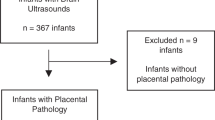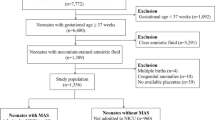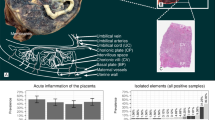Abstract
OBJECTIVE:
To determine whether the presence of histologic chorioamnionitis is associated with the severity of Persistent Pulmonary Hypertension of the Newborn (PPHN) as evidenced by the use of exogenous nitric oxide (iNO), high-frequency oscillatory ventilation (HFOV), extra-corporeal membrane oxygenation (ECMO) and/or death.
METHODS:
Retrospective chart review of term neonates ≥37 weeks gestation with PPHN. Placental pathology was reviewed. Primary outcome is the use of iNO. Secondary outcomes include the use of HFOV, ECMO and death.
RESULTS:
Over 2 years, 29 neonates fulfilled the entry criteria for the study. Interventions included iNO use n=14 (48%), HFOV n=7 (24%) and ECMO n=3 (10%); two neonates died. Histologic chorioamnionitis and/or funisitis was noted in 16 (55%) neonates. The presence of chorioamnionitis and/or funisitis (n=16) versus neither (n=13) was significantly associated with iNO use 11/16 (78%) versus 3/13 (22%) (p=0.02) and HFOV 7/16 (43%) versus 0/13 (0%) (p=0.008) but not to ECMO or death.
CONCLUSION:
The presence of histologic chorioamnionitis and/or funisitis is associated with more severe PPHN as indicated by the use of iNO as well as an increased requirement for more advanced respiratory support, that is, HFOV. The mechanism/s contributing to these findings are unclear.
This is a preview of subscription content, access via your institution
Access options
Subscribe to this journal
Receive 12 print issues and online access
$259.00 per year
only $21.58 per issue
Buy this article
- Purchase on Springer Link
- Instant access to full article PDF
Prices may be subject to local taxes which are calculated during checkout
Similar content being viewed by others

References
Frederick CM, Stenmark KR . Persistent pulmonary hypertension of the newborn. Am J Resp Crit Care Med 1995;151:2010–2032.
Kinsella JP, Abman SH . Efficacy of inhalational nitric oxide therapy in the clinical management of persistent pulmonary hypertension of the newborn. Chest 1994;105 (3):92S–94S.
Heyman J, Adams A, Gardner T . PPHN: trends, incidence, diagnosis, and management. Am J Dis Child 1984;138:592–595.
Davidson D, Barefield ES, Kattwinkel J, et al. Inhaled nitric oxide for the early treatment of persistent pulmonary hypertension of the newborn. Pediatrics 1998;101 (3):325–334.
The Neonatal Inhaled Nitric Oxide Group. Inhaled nitric oxide in full term and nearly full-term infants with hypoxic respiratory failure. N Engl J Med 1997;336:597–604.
Roberts JD, Morin III FC, Shaul PW, et al. Inhaled nitric oxide and persistent pulmonary hypertension of the newborn. New Engl J Med 1997;336:605–610.
Abman SH . Abnormal vasoreactivity in the pathophysiology of persistent pulmonary hypertension of the newborn. Neoreviews 1999;20 (11):e103–e109.
Zhang J, Patel JM, Li YD, et al. Proinflammatory cytokines downregulate gene expression and activity of eNOS in porcine pulmonary artery endothelial cells. Res Comm Molec Pathol Pharm 1997;96:71–87.
Venugopal SK, Devaraj S, Shaul P, et al. Demonstration that CRP decreases eNOS expression and bioactivity in human aortic endothelial cells. Circulation 2002;106:1439–1441.
Verma S, Wang CH, Stewart DJ, et al. A self-fulfilling prophecy. CRP attenuates NO production and inhibits angiogenesis. Circulation 2002;106:913–919.
Ziesche R, Petkov V, Williams J, et al. Lipopolysaccharide and interleukin 1 augement the effects of hypoxia and inflammation in human pulmonary arterial tissue. Proc Natl Acad Sci USA 1996;93:12478–12483.
Asrat T . Intra-amniotic infection in patients with preterm prelabor rupture of membranes. Pathophysiology, detection and management. Clin Perinatol 2001;28 (4):735–751.
Shalak LF, Laptook AR, Perlman JM, et al. Clinical chorioamnionitis, elevated cytokines, and brain injury in term infants. Pediatrics 2002;110 (4):673–680.
Ballard JL, Khoury JC, Wedig K, et al. New Ballard Score, expanded to include extremely premature infants. J Pediatr 1991;119:417–423.
Alexander JM, McIntire DM, Levino KJ . Chorioamnionitis and the prognosis for term infants. Obstet & Gynecol 1999;94:274–278.
Romero R, Salafia C, Athanissiadis AP, et al. The relationship between acute inflammatory lesions of the preterm placenta and amniotic fluid microbiology. Am J Obstet Gynecol 1992;166:1382–1388.
Gilstrap LC, Levino KJ, Burris J, et al. Diagnosis of birth asphyxia on the basis of fetal pH, Apgar score and newborn cerebral dysfunction. Am J Obstet Gynecol 1989;161:825–830.
Winkler CL, Hauth JC, Tucker JM, et al. Neonatal complications at term related to the degree of umbilical artery acidemia. Am J Obstet Gynecol 1991;164:637–641.
Cornfield DN, Chatfield BA, Abman SH, et al. Effect of birth related stimuli on L-arginine-dependent pulmonary vasodilation in ovine fetus. Am J Physiol 1992;31:H1474–H1481.
Shaul PW, Farrar MA, Zeller TM . Oxygen modulates endothelium-derived relaxing factor production in fetal pulmonary arteries. Am J Physiol 1992;262:H355–H364.
Morin III FC, Eagan EA, Ferguson W, et al. Development of pulmonary vascular response to oxygen. Am J Physiol 1998;254:H542–H546.
Konduri GG, Mattei J . Role of oxidative phosphorylation and ATP release in mediating birth-related pulmonary vasodilation in fetal lambs. Am J Physiol 2002;283 (4):H1600–H1608.
McQuillan LP, Gordon KL, Marsden PA, et al. Hypoxia inhibit expression of eNOS via transcriptional and post-transcriptional mechanisms. Am J Physiol 1994;267:H1921–H1927.
Author information
Authors and Affiliations
Rights and permissions
About this article
Cite this article
Woldesenbet, M., Perlman, J. Histologic Chorioamnionitis: An Occult Marker of Severe Pulmonary Hypertension in the Term Newborn. J Perinatol 25, 189–192 (2005). https://doi.org/10.1038/sj.jp.7211240
Published:
Issue Date:
DOI: https://doi.org/10.1038/sj.jp.7211240
This article is cited by
-
Histological chorioamnionitis at term according to labor onset: a prospective controlled study
Journal of Perinatology (2019)
-
Persistent Pulmonary Hypertension and Histologic Chorioamnionitis in Preterm Infants: Controlled Study
Pediatric Cardiology (2018)
-
Intrauterine inflammation alters cardiopulmonary but not cerebral hemodynamics during open endotracheal tube suction in preterm lambs
Pediatric Research (2013)


